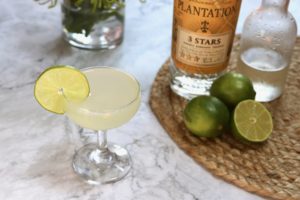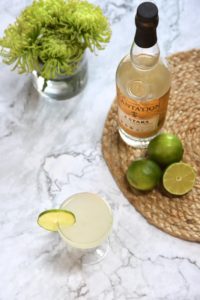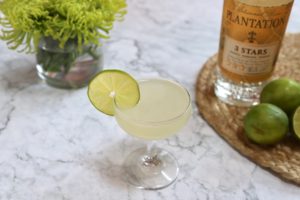
I’m continuing my little “Back to Basics” series by revisiting another cocktail that did not get its proper due when I first posted it: the Daiquiri. I was still so new to cocktails when I wrote my Daiquiri post that I was shocked that a real Daiquiri wasn’t bright red and frozen. I certainly didn’t know about the cult status it holds among those in the industry. It’s a go-to drink for many bartenders and cocktail enthusiasts. And in a way, this is a major gap in the history that I included in my original post, which didn’t extend past 1902. So that’s the main thing I want to remedy now, along with providing an updated recipe.
The Daiquiri, in its true form, is the essence of simplicity: rum, simple syrup, and lime juice. The main things that vary are the proportions and the type of rum. I prefer a white rum in my Daiquiri – for a long time, I used Bully Boy, but lately I’ve wanted something a bit drier and I reach for Cana Brava or Plantation 3 Stars. An aged rum will yield a richer flavor and a very different experience, but is also delicious. The Daiquiri is actually a fantastic template for tasting different rums and getting an idea of how they behave in cocktails. I don’t think there’s any wrong rum for a Daiquiri – it’s all a matter of preference.

The prominence of the Daiquiri as an industry drink originated, along with many things about the current craft cocktail culture that we know and love, with Sasha Petraske of Dutch Kills and Milk & Honey. For more on Sasha and his philosophy on bartending and cocktails, I encourage you to pick up a copy of Regarding Cocktails. But the Daiquiri was famously his favorite drink, so much so that after his untimely death in 2015, his friends and co-workers organized a worldwide Daiquiri toast in his honor.
One tradition that arose at Dutch Kills was the “Snaquiri.” Originally, this referred to a full-sized Daiquiri served in a tumbler that would be taken like a shot. As the practice of sharing a quick Daiquiri spread, the Snaquiri shrank to a more manageable 2 ounce size. Here in Boston, there’s a tradition where bartending staff partake of a DTO, or Daiquiri Time Out, and share a Snaquiri. I think it originated at the B-Side Lounge.
Making a good Daiquiri is often considered a test of a bartender’s skill. This may surprise you; something more along the lines of a Ramos Gin Fizz might pop to mind instead. But the simplicity of the Daiquiri leaves no room for error in the mind of a really discerning drinker. There is no hiding behind fancy ingredients or presentation. The choice of rum, the balance between the lime and simple syrup, the proper dilution – these things are placed front and center.
However! If you are a novice home bartender reading this, don’t despair. I do think the Daiquiri one of those unique drinks (like the Old Fashioned) that is easy to get right but difficult to get perfect. And if you’re relatively new to making drinks for yourself at home, the difference between these two things isn’t nearly as noticeable. So don’t let any of this intimidate you.
In fact, if you’ve never made a Daiquiri like this, or if it’s been a while since you’ve had one, I have a homework assignment for you: make yourself this Daiquiri. I mean it. I know you have lime juice, sugar, and rum. It’s such an easy drink, but such a special one.

History: Most historians agree that, given its common ingredients, the Daiquiri was probably invented multiple times. Rum was a widely available spirit in the Caribbean, and sailors drank lime juice to prevent scurvy. Mixing the two together with some sugar is just good sense. But the Daiquiri that rose to widespread popularity hails from Cuba, and gets its name from an iron mine outside of Santiago. I’ve found several versions of the story of its creation that at first seem like disparate accounts, but after some digging I think I’ve figured out how they all fit together – take it with a grain of salt. Jennings Cox, an American mining engineer, was working at the Daiquiri mine when he received a visit from F. D. Pagliuchi, another engineer of unclear nationality. Pagliuchi was interested in reviving some abandoned mines in the area. Cox couldn’t get his hands on any gin (the fashionable spirit of the time), and he was worried about serving Pagliuchi the local rum. So he mixed up a cocktail with lime and sugar to class it up. They named the concoction after the mine.
The Daiquiri was brought to the United States in 1902 by Congressman William A. Chanler. He had just gone to Cuba to check on his new investment, the El Cobre copper mine. Intrigued, I tried to find out more about the mine and came across some documents that list Pagliuchi as involved in its purchase and restoration. So it’s possible that Chanler was introduced to the Daiquiri by one of its creators. He brought the drink back to the best clubs in New York, where it became a classic cocktail.
Daiquiri
2 oz. rum
1 oz.* lime juice
3/4 oz. simple syrup
Combine all ingredients in a shaker with ice and shake until chilled. Strain into a coupe. No garnish needed, but a lime wheel won’t go amiss.
*Sasha Petraske’s recipe calls for 7/8 to 1 oz. lime juice, depending on the tartness of your lime. The more casual home bartender can probably just stick to 1 oz., but adjust the recipe to taste.
Recipe from Regarding Cocktails.






For my second book, Boston Cocktails: Drunk & Told, I did an interview with Andrew Dietz about the D.T.O. (he runs the D.T.O. site, crafted the logo, and runs its social media) and the B-Side was never mentioned. The B-Side definitely made Daiquiris, but he listed a 2010 trip to Martha’s Vineyard as where it all began. The full interview is in the book, but an abridged version is on my blog here:
https://cocktailvirgin.blogspot.com/2017/08/daiquiri-time-out.html